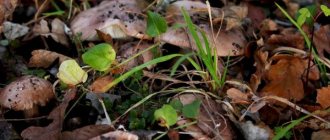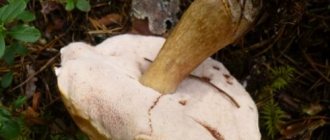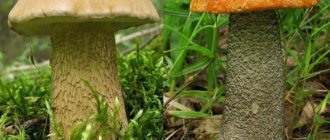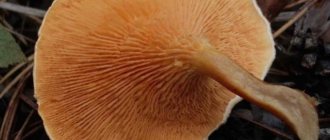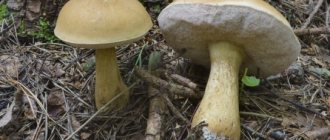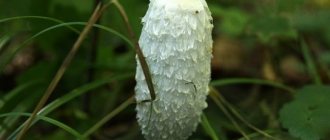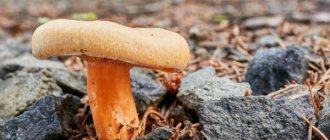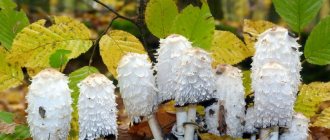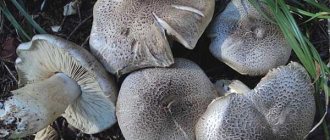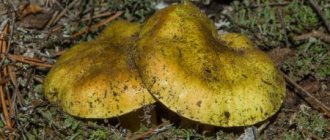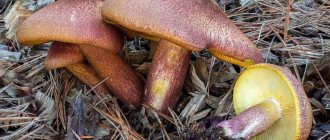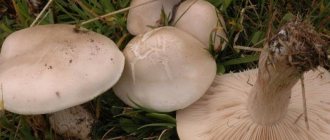Soap row - an inedible late autumn mushroom: description and photo. Features of the soap row, comparing it with similar mushrooms.
Hello dear reader!
October in our area is already late autumn. The mushroom picker has nothing to do in the forest at this time.
Just don't throw your slippers. I just expressed the opinion of the majority. Of course, even in late autumn you can find a lot of interesting things in the forest. Including both edible and tasty.
These are, first of all, a variety of rows and talkers. By the way, the main external difference between the rows and the talkers: in the talkers the plates run down the stem, while in the rows they may not even reach the stem. Knowing this, you can avoid some confusion.
I would definitely call the “queen” of the rowers the purple rower (Lepista nuda). Both taste and abundance of fruiting bodies. And the only way to confuse the mushroom is with the edible lilac-legged rower and the rather controversial weedy rower. But today we are not talking about them at all.
A significant part of the autumn rows have gray caps, which is why they are often called “little mice”. But among them there are both good edible and inedible, and even poisonous mushrooms. Here we need to understand.
Description of the mushroom
The rows grow in large groups, forming long rows. This is where their name comes from. Purely outwardly, the soap mushroom seems very attractive: after all, it can grow into a real giant with a huge cap and a rich color palette. Soap rows have a felt or scaly structure.
- Latin name: Tricholoma saponaceum. Department: Basidiomycetes.
- The mushroom belongs to the Ryadovkov family, the genus Ryadovok.
- The hat has a convex ball shape with uneven edges. Its diameter is 5–10 cm. In humid weather it becomes oily. Its color is uneven: it can be gray-green or brown-yellow. The middle is meaty and the edges are sharp.
- The hymenophore, or lower part of the cap, is filled with thick plates. If you press on them, you can find pink spots.
- The pulp is dense, white in color and has a bitter taste. When damaged, it slowly turns red. The skin is smooth, shiny, lighter at the edges. The mushroom is endowed with a pronounced smell of laundry soap and a bitter taste.
- The leg is cylindrical and widened towards the base. It can reach a length of 12 cm. Pale in color, sometimes covered with dark scales. With age, reddish spots appear on it.
- The spores are white.
Literally from Greek, ryadovka is translated as “hairy edge.” There are 45 species of it growing in Russia. The first scientific descriptions of them were recorded in 1857.
Answers to common questions
Paths often become a topic of discussion among mushroom pickers. Below is a list of the most frequently asked questions about rows with answers to them:
September rows are usually located among mixed forests with a predominance of spruce. Outwardly, they are pleasing to the eye, dense, stately, with good shape. There are many lovers of these spicy mushrooms with a unique, specific aroma.
In October, stinking rows are often found. They grow very widely near paths and in forest clearings. In October, you must smell all the mushrooms. As a result, you will quickly identify these dangerous, chemical-smelling mushrooms. Then you will distinguish them from similar edible pigeon rows, which do not smell of anything.
In October you can still find beautiful edible red and yellow rows. If frost has not passed, then they are bright and attractive. After frost, the color of the cap fades.
Before you go into the forest, find out what row mushrooms look like and where they grow.
Time and place of fruiting
The rows begin to bear fruit at the end of summer. This process continues until mid-October. You can find such mushrooms in coniferous and pine forests, as well as mixed ones. They can grow solitarily, but are more often united in groups. They are best known in the temperate northern zone. The fungus is considered widespread and is found in areas such as:
- Tver region;
- Karelia;
- Altai;
- Leningrad region;
- Ukraine;
- Western Europe.
REFERENCE! This type of mushroom can survive frosts and even be under snow.
Spathiphyllum
Its second name is “women’s happiness,” and that says it all. Girls who own this luxurious flower tirelessly develop the best mental and external qualities in themselves. As a result, they become unusually attractive to men.
Spathiphyllum helps to find your soulmate, adds love and harmony to relationships, and promotes procreation.
False doubles
Soap row is sometimes easy to confuse with other types. Photos of mushrooms and their descriptions will help you understand them correctly.
- Brown row. Conditionally edible, with a brown cap and edges turned inward. The skin color is usually reddish or yellow-orange. The center of the cap is always darker than the edges. One of the main distinguishing marks is the high leg.
- Gray. Edible mushroom with whitish dense flesh. The smell is pleasant - reminiscent of fresh flour. The taste is weak. The leg is rooted and immersed in moss or fallen foliage.
- Green. It is also called greenfly. It has a short leg that is almost hidden in the ground. The pulp is dense and white. The mushroom rarely goes stale. The color of the cap is greenish-yellow, with a pleasant cucumber smell.
- Golden. Edible mushroom of low quality. Its peculiarity is the release of droplets of juice. The leg is always noticeable by a pronounced zone of red scales. The flour aroma is faint. The flesh of the mushroom is white and dense.
Dangerous twins
| Name | Description |
| Tiger row | Black-brown cap with spots and a green tint. The smell of the mushroom is pungent but pleasant. Young specimens have a fibrous surface. The length of the stem varies: from 3 to 12 cm. The flesh of the mushroom is white with a gray coating under the skin. The main difference from other species: the presence of scales on the hat. |
| Pointed row (other names: mouse row and hot-sharp row). | It has a cap in the shape of a sharp bell of gray or black color with striped edges; the plates are grayish or whitish. Bitter taste of the pulp; in color it is first gray-white, and then becomes lighter. The mushroom stalk is cylindrical and dense; about 8 cm high. |
| The row is white or smelly | The mushroom has a fairly dense cap with closed edges; a small bump may form in its center. The skin color is white or grayish. The elastic and dense leg is a cylinder. The color of the pulp is white. A distinctive feature is the smell: when the fruiting body is damaged, it is very unpleasant. |
ATTENTION! The row family has many edible, conditionally edible and even poisonous variants. But the characteristic smell of cheap laundry soap is present only in this species.
Symptoms of poisoning from poisonous varieties can be detected approximately 3 hours after eating. They manifest themselves as weakness, vomiting, and sharp pain in the stomach.
There is no confusion. But in any case, in case of poisoning, you should consult a doctor.
Contraindications
Whatever the useful product and whatever gastronomic qualities it has, before consuming you should always take into account not only the benefits, but also the contraindications of red boletus
It is recommended to use the mushroom with caution in case of diseases:
- stomach,
- liver and gallbladder,
- kidney,
- intestines.
And in the acute stage, it is better to completely exclude dishes with red boletus from the diet. In any case, it would be a good idea to have a preliminary consultation with a doctor you trust.
In addition, contraindications to the use of red boletus are:
- having an allergy to mushrooms,
- pregnancy,
- lactation period.
If you are prone to allergic reactions, you need to be careful and include red boletus in your diet gradually, starting with a small amount. Individual intolerance is also possible
Since mushrooms are a rather difficult product for the digestive system, they are not recommended for children under 7 years of age.
Also, a dish with red boletus eaten in large quantities can cause harm, which consists of indigestion.
Literature:
Aurel Dermek. Mushrooms.
Lagutina T.V. The complete encyclopedia of mushrooms.
Polenov A.B. Mushrooms. Edible and inedible.
Vladimir Onishchenko. Mushroom Picker's Guide.
Anna Romanova, Alla Bulatova. Mushrooms. Illustrated guide to collection, processing, storage.
T.A. Ilyina. Mushrooms. Atlas-determinant.
Yu.I. Smirnyakov, A.K. Koshcheev. Mushroom picker's companion.
Taste assessment
Not everyone wants to eat soap bark because of its smell. However, experienced fans salt this type of mushroom with horseradish and garlic.
Research has proven that the pulp of these forest representatives contains a number of polysaccharides, which are famous for their excellent antitumor properties.
The fungus is also able to resist some bacteria. So, if in the field of cooking soap bars are not very popular, then in medicine, it is quite possible that they have a great future.
Collection rules
When collecting fruits, you need to adhere to a number of rules:
- choose only familiar mushrooms;
- give preference to young fruits;
- do not take damaged copies;
- clean the earth and dirt immediately, without leaving it for later.
Wicker baskets are used to collect mushrooms. You cannot use plastic buckets and bags where the fruiting bodies do not breathe and quickly deteriorate.
Important! You need to go for the rows after a good pouring rain. During the dry season, they quickly age and become unusable.
Cooking recipes
Primary processing
Wash the mushrooms thoroughly in plenty of running water and leave them to “soak” for several hours.
Cooking
Place a pan of water on the fire and pour a little vinegar into it. Boil for 10 minutes. Then the liquid is drained, the mushrooms are placed in a colander and the same procedure is performed a second time.
The rows are boiled in new water with the addition of vinegar for another 20 minutes. A peeled onion will help get rid of the unpleasant odor; it is thrown into the pan 10 minutes before the end of the procedure.
Ready mushrooms are washed with cold water. After this they can be salted. It is contraindicated to eat in large quantities. This may lead to poisoning.
How to salt a mushroom with garlic and horseradish?
For 5 kg of rows you will need:
- 200 g table salt;
- black currant leaves (2 pieces for each jar);
- horseradish leaves (to taste);
- garlic cloves (2-3 for each jar).
Cleaned, washed and free of soapy smell, mushrooms are placed in sterilized jars. First, half the seasonings and salt are placed in them.
Cover with the remaining portion of the ingredients. The jars are rolled up and put in a cool place. The product can be used after 45 days.
Interesting Facts
- In some countries, all rows are considered poisonous, but when properly processed, most of them are absolutely harmless.
- Mushrooms are beneficial because they contain large amounts of vitamin B.
- Rows (including soap rows) are used to prepare antibiotics and medicines.
When going to collect forest fruits, you should always be extremely attentive and careful. And if you are not confident in your knowledge, do not hesitate to ask experienced “hunters” for help. They will not only tell you the exact name of the fruiting body, but will also probably tell you many interesting facts about the mushroom kingdom.
Information sources
Noordeloos, M.E.; Christensen, M. P. Flora agaricina Neerlandica. — 1999
Chemical composition
Soap bar contains calcium, phosphorus, potassium, and in smaller quantities there is selenium, copper, manganese, sodium, iron, and zinc. The structure of the mushroom contains the entire group of vitamins B, PP, A, C, D2, D7, K, choline, and betaine. A large number of amino acids - phenylpropionic, aminopropane, diaminohexane, hydroxybutane, aspartic, stearic and glutamic.
